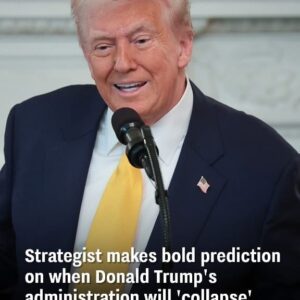On her second day at the Small Business Administration (SBA), former GOP senator Kelly Loeffler, now confirmed as the head of the agency, captured widespread attention with a video that has since gone viral. In the clip, Loeffler walked through the SBA offices in Washington, D.C., pointing out the stark reality: nearly 90% of federal employees are working from home. Her message was clear—this trend must end, as President Trump’s new executive order demands a return to the workplace.
A Bold Statement from Day One
Loeffler’s video, which has garnered tens of millions of views, begins with her expressing palpable enthusiasm about her new role. “It’s my second day here at the SBA,” she stated confidently, “and I could not be more excited to be here.” However, her tone shifted as she detailed her discovery during her walk-through. “I thought I’d take a walk, and what I found is that exactly what’s been said is true. About 90% of our employees are working from home.” Loeffler emphasized that this situation will change starting Monday, when a new directive—issued by President Trump—forces federal workers back into the office.
Her remarks were intended to highlight an issue that the Trump administration has long claimed is undermining efficiency and accountability in the federal workforce. According to Loeffler, the problem is not just the physical absence of employees from their desks but also the lack of performance accountability that remote work can sometimes foster.
Critics and Supporters Weigh In
The response to Loeffler’s revelations has been mixed and intense. Former Deputy Assistant Secretary of the Interior Department, Jeremy Carl, criticized the work-from-home model by stating, “The problem with work from home in the federal government is that the employees cannot be fired. When you don’t have to show up to the office, and there is no accountability for your performance, that is a recipe for disaster.” Such views underscore the administration’s belief that an in-person workforce is key to ensuring that government operations remain efficient and responsive.
On the other side of the debate, supporters of remote work have come to the defense of the flexible model that emerged during the COVID-19 pandemic. Anna Matson, a market researcher, argued passionately that the ability to work from home has become essential for many families. “This is one of the worst Trump policies,” Matson commented, noting that many households benefit from the balance of having one or both parents working remotely. “For some, adding extra hours in a long commute only detracts from valuable family time,” she added, warning that forcing a return to the office might push top talent to seek better opportunities in the private sector.
The Broader Context: Reassessing Federal Workforce Policies
The debate over remote work in federal agencies is emblematic of a larger discussion about the future of work in government. Prior to the pandemic, traditional in-office work was the norm, with daily commutes and structured office hours defining the federal work culture. The unprecedented shift to remote work during the COVID-19 crisis demonstrated that many roles could be performed effectively from home. However, as the country emerged from the pandemic, debates arose regarding the sustainability of this model.
The Trump administration’s executive order represents a deliberate attempt to reinstate traditional work practices in the federal sector. Proponents argue that physical presence in the office is essential for accountability and performance evaluation, while opponents see it as an outdated approach that fails to recognize the benefits of flexible working arrangements in today’s digital age.
The Role of the Department for Government Efficiency (DOGE)
Adding another layer to the discussion is the broader agenda of the Trump administration, particularly through initiatives led by the Department for Government Efficiency (DOGE). With Elon Musk’s support, DOGE has been actively working to cut wasteful spending and streamline operations across federal agencies. The push to end remote work is one facet of this larger strategy, aimed at ensuring that every dollar of taxpayer money is used efficiently and that government employees are held accountable for their performance.
Proponents of the DOGE initiative believe that returning to a traditional office setting will not only boost productivity but also contribute to a cultural shift within federal agencies—one where performance is closely monitored, and inefficiencies are promptly addressed. Critics, however, argue that such measures could be overly punitive and might lead to unintended consequences, such as the exodus of talented professionals to the private sector.
The Impact on Federal Employees and Families
The decision to mandate a return to the office has significant implications for federal employees, many of whom have adapted to the remote work model over the past few years. For many, the flexibility of working from home has been a boon—reducing commute times, allowing for a better work-life balance, and even providing opportunities to work from more geographically diverse locations. For others, the shift back to a traditional office environment represents a loss of these hard-won benefits.
In a landscape where work-life balance has become increasingly important, critics argue that the return-to-office mandate may not be well received by employees, particularly those with families. The potential for increased stress and reduced time with loved ones is a genuine concern that some fear could ultimately impact government efficiency in the long term.
Political Ramifications and the Future of Federal Work
Loeffler’s video and the subsequent debate have also taken on a distinctly political tone. The move to enforce a return to the office is being framed as part of a broader effort to revitalize federal operations under the Trump administration’s agenda of efficiency and accountability. However, the policy has already become a flashpoint in partisan debates, with critics labeling it as an unnecessary rollback of the progress made during the pandemic.
Former Trump attorney and current White House counselor Alina Habba recently made headlines by asserting that federal employees who do not prioritize “America first” may face termination—a statement that further underscores the administration’s hardline stance on workforce management. These political narratives have contributed to an environment where the debate over remote work is deeply intertwined with broader ideological battles over government efficiency, public spending, and the future of federal employment.
Conclusion: Balancing Efficiency, Accountability, and Flexibility
Kelly Loeffler’s tour of the SBA offices—and her pointed remarks about the high percentage of remote workers—has sparked a national conversation about the future of federal work. As the Trump administration pushes for a return to traditional office settings, the debate continues to polarize opinions. Proponents argue that in-person work is essential for accountability and efficiency, while critics contend that remote work has proven its worth by offering flexibility and better work-life balance.
In a rapidly evolving work environment, finding the right balance between efficiency, accountability, and flexibility is crucial. The outcome of this policy shift will likely have long-lasting implications not only for federal agencies but also for the broader American workforce.
What are your thoughts on the return-to-office mandate for federal employees? Is it a necessary move to boost accountability, or does it risk undermining the flexibility that has become essential for modern work-life balance? Share your opinions on Facebook and join the conversation as we explore the future of government work policies in a post-pandemic world.
In these transformative times, every policy decision shapes the future of our workforce. As we balance tradition with innovation, let’s engage in thoughtful dialogue about how best to support those who serve the American people while ensuring that progress and efficiency go hand in hand.





